Power Control
This tutorial demonstrates how to allocate transmission power on a per-user basis in a 3GPP-compliant multicell scenario in the uplink and downlink direction.
Uplink: Implemented by the open_loop_uplink_power_control function. This follows the open-loop power allocation procedure in 3GPP TS 38.213 [1], where the transmit power partially compensate for the pathloss by a factor \(\alpha\in[0;1]\) while targeting a received power of \(P_0\) [dBm];
Downlink: Handled by the downlink_fair_power_control function. This function maximizes a fairness function of the attainable throughput across the users on a per-sector basis.
Imports
We start by importing Sionna and the relevant external libraries:
[1]:
import os
os.environ['TF_CPP_MIN_LOG_LEVEL'] = '3'
if os.getenv("CUDA_VISIBLE_DEVICES") is None:
gpu_num = 0 # Use "" to use the CPU
if gpu_num!="":
print(f'\nUsing GPU {gpu_num}\n')
else:
print('\nUsing CPU\n')
os.environ["CUDA_VISIBLE_DEVICES"] = f"{gpu_num}"
# Import Sionna
try:
import sionna.sys
except ImportError as e:
import sys
if 'google.colab' in sys.modules:
# Install Sionna in Google Colab
print("Installing Sionna and restarting the runtime. Please run the cell again.")
os.system("pip install sionna")
os.kill(os.getpid(), 5)
else:
raise e
# Configure the notebook to use only a single GPU and allocate only as much memory as needed
# For more details, see https://www.tensorflow.org/guide/gpu
import tensorflow as tf
tf.get_logger().setLevel('ERROR')
gpus = tf.config.list_physical_devices('GPU')
if gpus:
try:
tf.config.experimental.set_memory_growth(gpus[0], True)
except RuntimeError as e:
print(e)
[2]:
# Additional external libraries
import matplotlib.pyplot as plt
import numpy as np
# Sionna components
from sionna.phy.utils import log2, dbm_to_watt, watt_to_dbm
from sionna.phy.constants import BOLTZMANN_CONSTANT
from sionna.phy.channel import GenerateOFDMChannel
from sionna.phy.ofdm import ResourceGrid, RZFPrecodedChannel, \
EyePrecodedChannel, LMMSEPostEqualizationSINR
from sionna.phy.channel.tr38901 import UMi, PanelArray
from sionna.phy.mimo import StreamManagement
from sionna.sys import gen_hexgrid_topology, \
downlink_fair_power_control, open_loop_uplink_power_control
from sionna.sys.utils import spread_across_subcarriers, get_pathloss
# Internal computational precision
sionna.phy.config.precision = 'single' # 'single' or 'double'
# Set random seed for reproducibility
sionna.phy.config.seed = 45
Multicell scenario
We first create a multicell 3GPP-compliant scenario on which power control will be performed in both the uplink and downlink directions.
Simulation Parameters
We define the main simulation parameters, including the topology settings, OFDM resource grid, and transmission power for the base stations and user terminal.
[3]:
# Number of independent scenarios
batch_size = 1
# Number of rings of the spiral hexagonal grid
num_rings = 1
# Number of co-scheduled users per sector
num_ut_per_sector = 5
# OFDM resource grid
num_ofdm_sym = 10
num_subcarriers = 32
subcarrier_spacing = 15e3 # [Hz]
carrier_frequency = 3.5e9 # [Hz]
# Base station and user terminal transmit power
bs_max_power_dbm = 46 # [dBm]
ut_max_power_dbm = 26 # [dBm]
# Convert power to Watts
ut_max_power = dbm_to_watt(ut_max_power_dbm) # [W]
bs_max_power = dbm_to_watt(bs_max_power_dbm) # [W]
# Environment temperature
temperature = 294 # [K]
# Noise power per subcarrier
no = BOLTZMANN_CONSTANT * temperature * subcarrier_spacing
# Max distance between user terminal and serving base station
max_bs_ut_dist = 80 # [m]
Antenna patterns
We create the antenna patterns for base stations and user terminals.
[4]:
# Create antenna arrays
bs_array = PanelArray(num_rows_per_panel=3,
num_cols_per_panel=2,
polarization='dual',
polarization_type='VH',
antenna_pattern='38.901',
carrier_frequency=carrier_frequency)
ut_array = PanelArray(num_rows_per_panel=1,
num_cols_per_panel=1,
polarization='single',
polarization_type='V',
antenna_pattern='omni',
carrier_frequency=carrier_frequency)
num_ut_ant = ut_array.num_ant
num_bs_ant = bs_array.num_ant
Topology
Next, we position base stations on a hexagonal grid according to a 3GPP-compliant scenario and randomly distribute users uniformly in each sector.
For more details on the generation of the topology, see the Hexagonal Grid Topology notebook.
[5]:
# Generate the spiral hexagonal grid topology
topology = gen_hexgrid_topology(batch_size=batch_size,
num_rings=num_rings,
num_ut_per_sector=num_ut_per_sector,
max_bs_ut_dist=max_bs_ut_dist,
scenario='umi')
ut_loc, bs_loc, *_ = topology
# N. users and base stations
num_bs = bs_loc.shape[1]
num_ut = ut_loc.shape[1]
# In the uplink, the user is the transmitter and the base station is the receiver
num_rx, num_tx = num_bs, num_ut
We set and compute the number of streams per user and base station, respectively.
[6]:
# Set number of streams per user
num_streams_per_ut = num_ut_ant
# Number of streams per base station
num_streams_per_bs = num_streams_per_ut * num_ut_per_sector
assert num_streams_per_ut <= num_ut_ant, \
"The # of streams per user must not exceed the # of its antennas"
Each receiver is associated with its serving base station.
[7]:
# For simplicity, each user is associated with its nearest base station
# Uplink
# RX-TX association matrix
rx_tx_association_ul = np.zeros([num_rx, num_tx])
idx_fair = np.array([[i1, i2] for i1 in range(num_rx) for i2 in
np.arange(i1*num_ut_per_sector, (i1+1)*num_ut_per_sector)])
rx_tx_association_ul[idx_fair[:, 0], idx_fair[:, 1]] = 1
# Instantiate a Stream Management object
stream_management_ul = StreamManagement(rx_tx_association_ul, num_streams_per_ut)
# Downlink
# Receivers and transmitters are swapped wrt uplink
rx_tx_association_dl = rx_tx_association_ul.T
stream_management_dl = StreamManagement(rx_tx_association_dl, num_streams_per_bs)
We create the channel model that will be used to generate the channel impulse responses:
[8]:
# Create channel model
channel_model = UMi(carrier_frequency=carrier_frequency,
o2i_model='low', # 'low' or 'high'
ut_array=ut_array,
bs_array=bs_array,
direction='uplink',
enable_pathloss=True,
enable_shadow_fading=True)
channel_model.set_topology(*topology)
channel_model.show_topology()
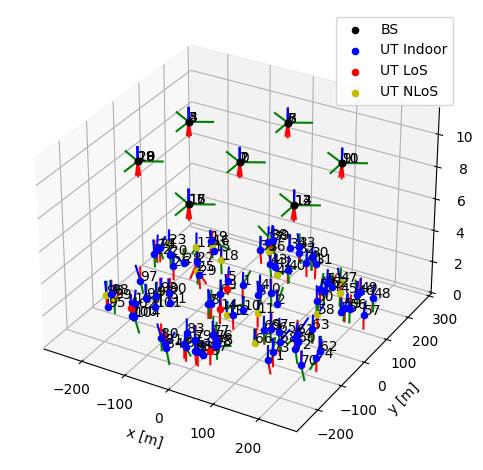
Channel
Next, the channel frequency response is computed over the OFDM resource grid.
[9]:
# Set up the OFDM resource grid
resource_grid = ResourceGrid(num_ofdm_symbols=num_ofdm_sym,
fft_size=num_subcarriers,
subcarrier_spacing=subcarrier_spacing,
num_tx=num_ut_per_sector,
num_streams_per_tx=num_streams_per_ut)
# Instantiate the OFDM channel generator
ofdm_channel = GenerateOFDMChannel(channel_model, resource_grid)
# Generate the OFDM channel matrix in the uplink
# [batch_size, num_rx=num_bs, num_rx_ant, num_tx=num_ut, num_tx_ant, num_ofdm_symbols, num_subcarriers]
h_freq_ul = ofdm_channel(batch_size)
# [batch_size, num_rx=num_ut, num_rx_ant, num_tx=num_bs, num_tx_ant, num_ofdm_symbols, num_subcarriers]
h_freq_dl = tf.transpose(h_freq_ul, [0, 3, 4, 1, 2, 5, 6])
[10]:
# For simplicity, all users are allocated simultaneously on all resources
is_scheduled = tf.fill([batch_size,
num_bs,
num_ofdm_sym,
num_subcarriers,
num_ut_per_sector,
num_streams_per_ut],
True)
num_allocated_subcarriers = tf.fill([batch_size,
num_bs,
num_ofdm_sym,
num_ut_per_sector],
num_subcarriers)
Uplink power control
According to the open-loop power control procedure defined in 3GPP TS 38.213 [1], the transmit power allocated to a user compensates the pathloss \(PL\) from the serving base station by a factor \(\alpha\in[0;1]\) while targeting a received power \(P_0\) [dBm]:
\(P^{\mathrm{UL}} = \min \{ P_0 + \alpha PL + 10 \log_{10}(\mathrm{\#PRB}), P^{\mathrm{max}}_{\mathrm{ut}}\} \quad \mathrm{[dBm]}\)
where \(P^{\mathrm{max}}_{\mathrm{ut}}\) [dBm] is the maximum transmit power for the terminal and \(\mathrm{\#PRB}\) is the number of physical resource blocks allocated to the user.
As a first step, we compute the pathloss for each user:
[11]:
_, pathloss_serving_cell = get_pathloss(
h_freq_ul,
rx_tx_association=tf.cast(rx_tx_association_ul, dtype=tf.int32))
def group_by_bs(tensor):
tensor = tf.reshape(
tensor, [batch_size, num_bs, num_ut_per_sector, num_ofdm_sym])
# [batch_size, num_bs, num_ofdm_symbols, num_ut_per_sector]
return tf.transpose(tensor, [0, 1, 3, 2])
# Group by base station
# [batch_size, num_bs, num_ut_per_sector, num_ofdm_sym]
pathloss_serving_cell = group_by_bs(pathloss_serving_cell)
[12]:
@tf.function(jit_compile=True)
def get_sinr_uplink(h_freq,
pathloss_serving_cell,
alpha,
p0_dbm,
ut_max_power_dbm,
num_allocated_subcarriers,
is_scheduled):
""" Compute the uplink SINR """
# Per-user uplink transmit power
# [batch_size, num_bs, num_ofdm_sym, num_ut_per_sector]
ul_power_per_ut = open_loop_uplink_power_control(
pathloss_serving_cell,
num_allocated_subcarriers,
alpha=alpha,
p0_dbm=p0_dbm,
ut_max_power_dbm=ut_max_power_dbm)
# Spread power uniformly across subcarriers
# [batch_size, num_bs, num_ut_per_sector, num_streams_per_ut, num_ofdm_sym,
# num_subcarriers]
ul_power = spread_across_subcarriers(
ul_power_per_ut,
is_scheduled,
num_tx=num_ut_per_sector)
ul_power = tf.reshape(ul_power,
[batch_size, num_ut, num_streams_per_ut,
num_ofdm_sym, num_subcarriers])
# Compute SINR
precoded_channel = EyePrecodedChannel(resource_grid=resource_grid,
stream_management=stream_management_ul)
h_eff = precoded_channel(h_freq, tx_power=ul_power)
lmmse_posteq_sinr = LMMSEPostEqualizationSINR(resource_grid=resource_grid,
stream_management=stream_management_ul)
# [batch_size, num_ofdm_symbols, num_effective_subcarriers, num_rx, num_streams_per_rx]
sinr = lmmse_posteq_sinr(h_eff, no=tf.cast(no, tf.float32), interference_whitening=True)
# [batch_size, num_ofdm_symbols, num_effective_subcarriers, num_ut, num_streams_per_ut]
sinr = tf.reshape(sinr, sinr.shape[:-2] + [num_ut, num_streams_per_ut])
return sinr, ul_power_per_ut
Impact of parameters on system performance
[13]:
def get_se(sinr):
""" Compute the spectral efficiency """
se_per_ut = tf.reduce_sum(log2(1 + sinr), axis=[4])
# Average across OFDM symbols and subcarriers
return tf.reduce_mean(se_per_ut, axis=[1, 2])
# Values of (alpha, P0) to evaluate
alpha_vec = np.linspace(.5, 1, 50)
p0_dbm_vec = np.arange(-110, -69, 1)
# Per-user spectral efficiency per user across (alpha, P0) values
se_per_ut_ul_mat = np.zeros([len(p0_dbm_vec), len(alpha_vec), num_ut*batch_size])
ul_power_mat = np.zeros([len(p0_dbm_vec), len(alpha_vec), num_ut*batch_size])
# Compute the spectral efficiency for each (alpha, P0) pair
for idx_p0, p0_dbm in enumerate(p0_dbm_vec):
for idx_alpha, alpha in enumerate(alpha_vec):
# Compute SINR and UL power distribution
# sinr: [batch_size, num_ofdm_symbols, num_effective_subcarriers, num_ut,
# num_streams_per_ut]
# ul_power_per_ut: # [batch_size, num_bs, num_ofdm_sym, num_ut_per_sector]
sinr, ul_power_per_ut = get_sinr_uplink(
h_freq_ul,
pathloss_serving_cell,
alpha,
p0_dbm,
ut_max_power_dbm,
num_allocated_subcarriers,
is_scheduled)
# Compute the spectral efficiency
se_per_ut_ul_mat[idx_p0, idx_alpha, :] = get_se(sinr).numpy().flatten()
# Power allocation
ul_power_mat[idx_p0, idx_alpha, :] = ul_power_per_ut.numpy().mean(axis=2).flatten()
To illustrate the impact of the design parameters \((\alpha, P_0)\) on network performance, we evaluate the \(x\)-th percentile of the spectral efficiency distribution across users, that we want to maximize as a function of \((\alpha, P_0)\).
[14]:
xth_percentile = 10
metric_mat = np.zeros([len(p0_dbm_vec), len(alpha_vec)])
for idx_p0, p0_dbm in enumerate(p0_dbm_vec):
for idx_alpha, alpha in enumerate(alpha_vec):
metric_mat[idx_p0, idx_alpha] = np.nanpercentile(
se_per_ut_ul_mat[idx_p0, idx_alpha, :], xth_percentile)
plt.figure(figsize=(8, 6))
plt.imshow(metric_mat, aspect='auto')
plt.colorbar()
plt.ylabel(r'Target received power $P_0$ [dBm]')
plt.xlabel(r'Pathloss compensation factor $\alpha$')
plt.title(f'{xth_percentile}-th percentile of user spectral efficiency [bps/Hz]')
plt.yticks(np.arange(len(p0_dbm_vec)), p0_dbm_vec)
plt.gca().invert_yaxis()
show_every = 3
plt.xticks(np.arange(0, len(alpha_vec), show_every),
[f'{alpha_vec[i]:.2f}' for i in range(0, len(alpha_vec), show_every)], rotation=45)
plt.yticks(np.arange(0, len(p0_dbm_vec), show_every),
[p0_dbm_vec[i] for i in range(0, len(p0_dbm_vec), show_every)], rotation=45)
plt.show()
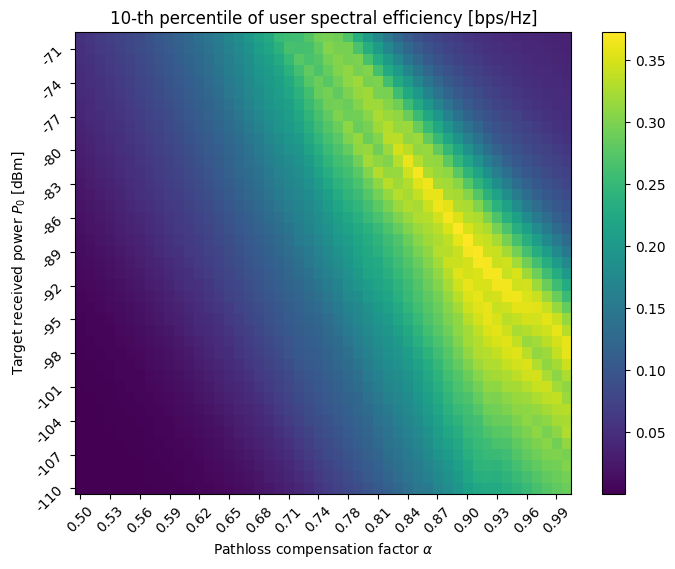
It is also interesting to evaluate the distribution of the power allocation across users.
[15]:
def get_cdf(values):
"""
Computes the Cumulative Distribution Function (CDF) of the input
"""
values = np.array(values).flatten()
n = len(values)
sorted_val = np.sort(values)
cumulative_prob = np.arange(1, n+1) / n
return sorted_val, cumulative_prob
alpha_po_vec = [(.9, -100), (1., -100), (.9, -80)]
fig, ax = plt.subplots()
for alpha, po in alpha_po_vec:
idx_p0, idx_alpha = np.argmin(np.abs(p0_dbm_vec - po)), np.argmin(np.abs(alpha_vec - alpha))
ax.plot(*get_cdf(ul_power_mat[idx_p0, idx_alpha, :]*1e3),
label=fr'$\alpha=${alpha_vec[idx_alpha]:.2f}, $P_0$={p0_dbm_vec[idx_p0]}')
ax.plot([dbm_to_watt(ut_max_power_dbm)*1e3]*2, [0, 1], 'k--', label='max UT power')
ax.set_xlabel('Per-user uplink transmit power [mW]')
ax.set_ylabel('CDF')
ax.legend()
ax.grid()
plt.show()
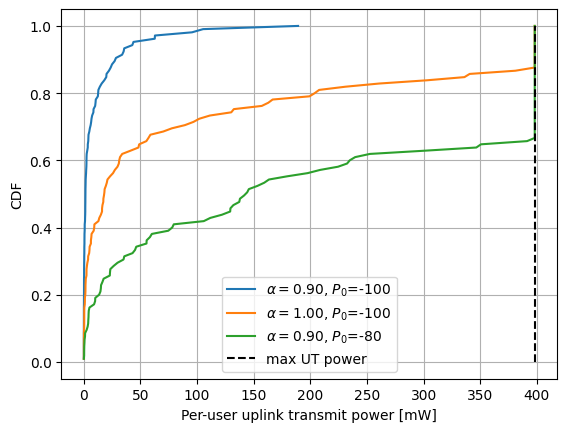
As expected, an increase of either the pathloss compensation factor \(\alpha\) or the target received power \(P_0\) leads to a higher power allocation, which eventually saturates at the maximum transmit power for the user terminal.
Downlink power control
In the downlink, the base station distributes the per-resource transmit power \(p_u\) across different users \(u=1,\dots,P\).
The function downlink_fair_power_control maximizes a fairness function \(g^{(f)}\) defined as in [2] of the maximum attainable throughput:
where \(q_u\) is a measure of the channel quality for user \(u\) and \(r_u\) is the number of allocated resources for \(u\).
The base station transmit power must not exceed \(P^{\mathrm{max}}_{\mathrm{bs}}\):
Moreover, to ensure that all scheduled users obtain a positive throughput, we can impose a lower bound on the individual allocated powers:
where \(0\le \rho \le 1\). Note that if \(\rho=1\), then all users obtain the same power allocation.
To estimate the channel quality for each user, we compute the pathloss from the serving cell and the interference from all neighboring cells.
[16]:
# Pathloss
# [batch_size, num_ut, num_bs, num_ofdm_symbols], [batch_size, num_ut, num_ofdm_symbols]
pathloss_all_pairs, pathloss_serving_cell = get_pathloss(
h_freq_dl,
rx_tx_association=tf.cast(rx_tx_association_dl, dtype=tf.int32))
# Interference from all base stations
# [batch_size, num_ut, num_ofdm_symbols]
one = tf.cast(1, pathloss_serving_cell.dtype)
interference_dl = tf.reduce_sum(
one / pathloss_all_pairs, axis=-2) - one / pathloss_serving_cell
interference_dl *= bs_max_power
# Group by base station
# [batch_size, num_bs, num_ut_per_sector, num_ofdm_sym]
pathloss_serving_cell = group_by_bs(pathloss_serving_cell)
interference_dl = group_by_bs(interference_dl)
Impact of parameters on system performance
The downlink power allocation procedure in downlink_fair_power_control is governed by two parameters:
the fairness parameter \(f\), defined as in [2]. If \(f=0\), then the sum of throughput is maximized, favoring users with good channel conditions while potentially leaving those in poor conditions without power. As \(f\) increases, the allocation becomes more egalitarian across users;
the guaranteed power ratio \(\rho\), which defines the minimum power allocation per user.
To evaluate the impact of these two design parameters on the network performance, we evaluate the spectral efficiency distribution as \((f,\rho)\) vary.
[17]:
def get_sinr_downlink(guaranteed_power_ratio,
fairness_dl):
""" Compute the downlink SINR """
# [batch_size, num_bs, num_ofdm_symbols, num_ut_per_sector]
dl_power_per_ut, _ = downlink_fair_power_control(
pathloss_serving_cell,
interference_dl + no,
num_allocated_subcarriers,
bs_max_power_dbm=bs_max_power_dbm,
guaranteed_power_ratio=guaranteed_power_ratio,
fairness=fairness_dl)
# Spread power uniformly across subcarriers
# [batch_size, num_bs, num_ut_per_sector, num_streams_per_ut, num_ofdm_sym, num_subcarriers]
dl_power = spread_across_subcarriers(
dl_power_per_ut,
is_scheduled,
num_tx=1)
dl_power = tf.reshape(dl_power,
[batch_size, num_bs, num_streams_per_bs,
num_ofdm_sym, num_subcarriers])
precoded_channel = RZFPrecodedChannel(resource_grid=resource_grid,
stream_management=stream_management_dl)
h_eff = precoded_channel(h_freq_dl, tx_power=dl_power, alpha=no)
lmmse_posteq_sinr = LMMSEPostEqualizationSINR(resource_grid=resource_grid,
stream_management=stream_management_dl)
# [batch_size, num_ofdm_symbols, num_subcarriers, num_ut, num_streams_per_ut]
sinr = lmmse_posteq_sinr(h_eff, no=no, interference_whitening=True)
return sinr, dl_power_per_ut
[18]:
# Fairness parameters to evaluate
fairness_dl_vec = [0, .5, 1]
# Guaranteed power ratio to evaluate
guaranteed_power_ratio_vec = [0, .3]
# Per-user spectral efficiency per user across (fairness, guaranteed power ratio) values
se_per_ut_dl_mat = np.zeros([len(fairness_dl_vec),
len(guaranteed_power_ratio_vec), num_ut*batch_size])
dl_power_mat = np.zeros([len(fairness_dl_vec),
len(guaranteed_power_ratio_vec), num_ut*batch_size])
# Compute the spectral efficiency for each (fairness, guaranteed power ratio) pair
for idx_guar, guaranteed_power_ratio in enumerate(guaranteed_power_ratio_vec):
for idx_fair, fairness_dl in enumerate(fairness_dl_vec):
# Compute SINR and DL power distribution
sinr, dl_power_per_ut = get_sinr_downlink(guaranteed_power_ratio, fairness_dl)
# Spectral efficiency
se_per_ut_dl_mat[idx_fair, idx_guar, :] = get_se(sinr).numpy().flatten()
# Power allocation
dl_power_mat[idx_fair, idx_guar, :] = dl_power_per_ut.numpy().mean(axis=2).flatten()
Finally, we visualize the spectral efficiency distribution across the different values of fairness \(f\) and guaranteed power ratio \(\rho\).
[19]:
fig, axs = plt.subplots(len(guaranteed_power_ratio_vec),
figsize=(5, 4*len(guaranteed_power_ratio_vec)))
for idx_guar, guaranteed_power_ratio in enumerate(guaranteed_power_ratio_vec):
axs[idx_guar].set_title(r'Guaranteed power ratio $\rho$ =' + f'{guaranteed_power_ratio}')
for idx_fair, fairness_dl in enumerate(fairness_dl_vec):
axs[idx_guar].plot(*get_cdf(se_per_ut_dl_mat[idx_fair, idx_guar, :]), label=f'Fairness $f$ = {fairness_dl}')
for ax in axs:
ax.grid()
ax.legend()
ax.set_xlabel('Per-user spectral efficiency [bps/Hz]')
ax.set_ylabel('Cumulative density function')
fig.tight_layout()
plt.show()
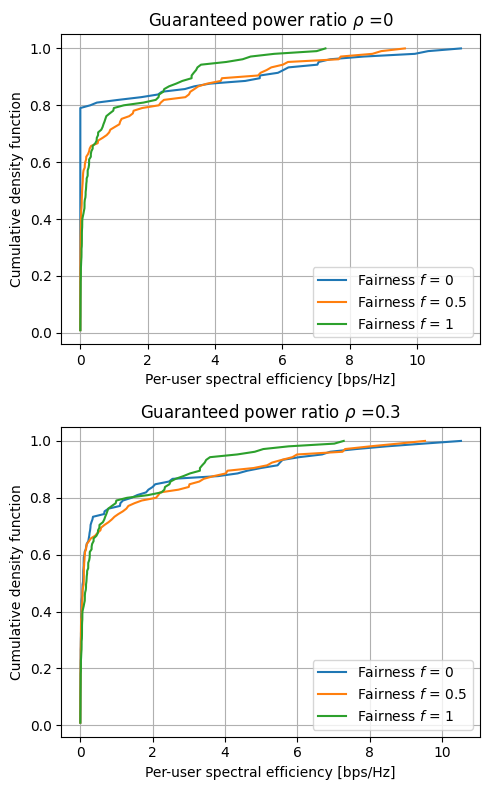
It is also interesting to evaluate the power allocation distribution for different values of fairness \(f\) and guaranteed power ratio \(\rho\).
[20]:
fairness_guar_ratio_vec = [(0, 0), (0, .5), (1, 0)]
fig, ax = plt.subplots()
for fairness, guaranteed_power_ratio in fairness_guar_ratio_vec:
idx_fair = np.argmin(np.abs(np.array(fairness_dl_vec) - fairness))
idx_guar = np.argmin(np.abs(np.array(guaranteed_power_ratio_vec) - guaranteed_power_ratio))
ax.plot(*get_cdf(dl_power_mat[idx_fair, idx_guar, :]),
label=fr'$f$={fairness_dl_vec[idx_fair]:.1f}, $\rho$= {guaranteed_power_ratio_vec[idx_guar]:.1f}')
ax.plot([dbm_to_watt(bs_max_power_dbm)]*2, [0, 1], 'k--', label='max BS power')
ax.set_xlabel('Per-user downlink transmit power [W]')
ax.set_ylabel('Cumulative density function')
ax.legend()
ax.grid()
plt.show()
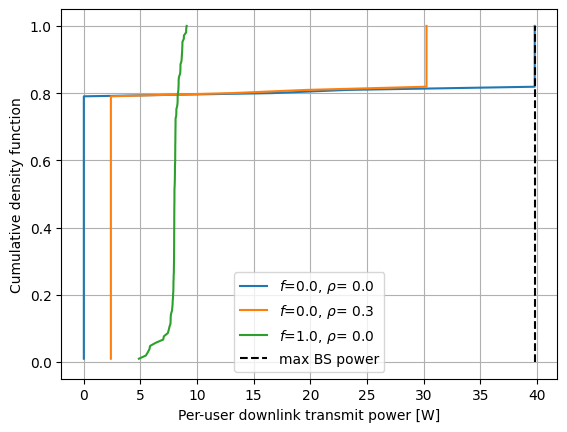
For computational efficiency, we recommend setting \(f=0\) and choosing \(\rho >0\) to ensure that all users receive some power allocation.
Conclusions
Power allocation in both uplink and downlink requires a global perspective on the network to ensure fairness across all served users.
We provide two built-in functions for this purpose:
open_loop_uplink_power_control for uplink power allocation following the open-loop procedure described in 3GPP TS 38.213 [1]
downlink_fair_power_control for fair downlink power allocation.